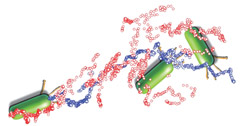UCLA study shows bacteria use Batman-like grappling hooks to 'slingshot' on surfaces

Slingshot bacteria<br>
“TFP act like Batman's grappling hooks,” said Gerard Wong, a professor of bioengineering and of chemistry and biochemistry at the UCLA Henry Samueli School of Engineering and Applied Science and the California NanoSystems Institute (CNSI) at UCLA. “These grappling hooks can extend and bind to a surface and retract and pull the cell along.”
In a study to be published online this week in Proceedings of the National Academy of Sciences, Wong and his colleagues at UCLA Engineering identify the complex sequence of movements that make up this twitching motility in Pseudomonas aeruginosa, a biofilm-forming pathogen partly responsible for the deadly infections seen in cystic fibrosis.
During their observations, Wong and his team made a surprising discovery. Using a high-speed camera and a novel two-point tracking algorithm, they noticed that the bacteria had the unique ability to “slingshot” on surfaces.
The team found that linear translational pulls of constant velocity alternated with velocity spikes that were 20 times faster but lasted only milliseconds. This action would repeat over and over again.
“The constant velocity is due to the pulling by multiple TFP; the velocity spike is due to the release of a single TFP,” Wong said. “The release action leads to a fast slingshot motion that actually turns the bacteria efficiently by allowing it to over-steer.”
The ability to turn and change direction is essential for bacteria to adapt to continually changing surface conditions as they form biofilms. The researchers found that the slingshot motion helped P. aeruginosa move much more efficiently through the polysaccharides they secrete on surfaces during biofilm formation, a phenomenon known as shear-thinning.
“If you look at the surfaces the bacteria have to move on, they are usually covered in goop. Bacterial cells secrete polysaccharides on surfaces, which are kind of like molasses,” Wong said. “Because these polysaccharides are long polymer molecules that can get entangled, these are very viscous and can potentially impede movement. However, if you move very fast in these polymer fluids, the viscosity becomes much lower compared to when you're moving slowly. The fluid will then seem more like water than molasses. This kind of phenomenon is well known to chemical engineers and physicists.”
Since the twitching motion of bacteria with TFP depends of the physical distributions of TFP on the surface of individual cells, Wong hopes that the analysis of motility patterns may in the future enable new methods for biometric “fingerprinting” of individual cells for single-cell diagnostics.
“It gives us the possibility of not just identifying species of bacteria but the possibility of also identifying individual cells. Perhaps in the future, we can look at a cell and try to find the same cell later on the basis of how it moves,” he said.
The study was funded by the National Institutes of Health and the National Science Foundation. The lead authors are Fan Jin from the UCLA Department of Bioengineering, the UCLA Department Chemistry and Biochemistry, and the CNSI, and Jacinta C. Conrad of the department of chemical and biomolecular engineering at the University of Houston.
The UCLA Henry Samueli School of Engineering and Applied Science, established in 1945, offers 28 academic and professional degree programs and has an enrollment of almost 5,000 students. The school's distinguished faculty are leading research to address many of the critical challenges of the 21st century, including renewable energy, clean water, health care, wireless sensing and networking, and cybersecurity. Ranked among the top 10 engineering schools at public universities nationwide, the school is home to seven multimillion-dollar interdisciplinary research centers in wireless sensor systems, nanoelectronics, nanomedicine, renewable energy, customized computing, and the smart grid, all funded by federal and private agencies. (www.engineer.ucla.edu | www.twitter.com/uclaengineering)
For more UCLA news, visit UCLA Newsroom and UCLA News|Week and follow us on Twitter.
Media Contact
More Information:
http://www.ucla.eduAll latest news from the category: Life Sciences and Chemistry
Articles and reports from the Life Sciences and chemistry area deal with applied and basic research into modern biology, chemistry and human medicine.
Valuable information can be found on a range of life sciences fields including bacteriology, biochemistry, bionics, bioinformatics, biophysics, biotechnology, genetics, geobotany, human biology, marine biology, microbiology, molecular biology, cellular biology, zoology, bioinorganic chemistry, microchemistry and environmental chemistry.
Newest articles

Superradiant atoms could push the boundaries of how precisely time can be measured
Superradiant atoms can help us measure time more precisely than ever. In a new study, researchers from the University of Copenhagen present a new method for measuring the time interval,…

Ion thermoelectric conversion devices for near room temperature
The electrode sheet of the thermoelectric device consists of ionic hydrogel, which is sandwiched between the electrodes to form, and the Prussian blue on the electrode undergoes a redox reaction…

Zap Energy achieves 37-million-degree temperatures in a compact device
New publication reports record electron temperatures for a small-scale, sheared-flow-stabilized Z-pinch fusion device. In the nine decades since humans first produced fusion reactions, only a few fusion technologies have demonstrated…





















